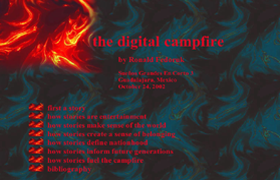In this passage from William Gibson's novel Neuromancer, the multimedia conversation is taking place among four participants: Case is human; Armitage is a video clip - downloaded from the cyberspace matrix; the Hosaka is hardware - the portable computer deck that Case uses; and the Flatline is software - a virtual intelligence created to aid with this particular search. Writing more than 20 years ago, Gibson created a world where people are completely comfortable using a communications deck that, when it becomes reality, will be called a "Laptop"; storing information in a matrix that, when it becomes reality, will be called the "Internet"; and navigating through a cyberspace that, when it becomes reality, will be called"Cyberspace". Gibson put his mind through to this Brave New World in 1984, and it is now that our bodies are literally being pulled after.
Case takes his technical dexterity for granted. He has come to expect this level of functionality, and he becomes frustrated and annoyed whenever he has to use only a single medium at any given time. He has mentally and even physically adapted to the new technology, his senses have become conditioned to this level of stimulation, and his thought process has been speeded up to assimilate the various information. The characters of Neuromancer have created an altered language and cultural traits that are specific to and centred on the use of media. We believe it because we know it is possible. This kind of adaptation is very much as Ong describes in comparing the cultural shift from orality to literacy.
http://www.theatre.ubc.ca/fedoruk/campfire

The text of this current presentation and related essays on this theme are part of my attempt to adapt to the inherently non-linear environment of hypertext. The essays are written and stored in html, and they are posted on my website as a matter of course. All the presentations in this series rely primarily on text. The images serve as links and they do give some visual information about the formatting and style of the material under discussion. Hypertext in these esssays is used generally as a means of citation. Normal citation styles have been excluded, because they are useful only if the essay is printed. Since much of the meaning is lost in print form, I wish to make every possible effort to encourage the reader to stay in a hypertext mode.
As a style of citation, this has an added advantage. Links go directly to the sources, allowing the reader immediate access to corroborating information. Or the reader can choose to go outside the text to explore tangential ideas. In effect, my work is part of a much larger set of research, and the reader is no longer limited to the information contained within my essay. While I like to think I am offering some valid ideas, the more important function is that my essay now serves as the entry point for the reader into a much larger interconnected discourse.
The great efficiency is that where other authors have eloquently made a case that is parallel or complementary to the thesis I present, I do not need to restate the case other than to briefly summarize. For instance an extensive discussion of hypertext is contained in Katherine Hayles essay "Flickering Connectivities in Shelley Jackson's Patchwork Girl: The Importance of Media-Specific Analysis". Patchwork Girl is an early hypertext published by Eastgate Systems as a compact disc. It is not accessible on the Internet although many of the same arguments apply.
Of course print publications relate one to another as well, but there the process is slower. In preparation for a course in the coming semester, I am rereading Friederich Nietzsche's The Birth of Tragedy, written in 1872. The edition I have was translated with a commentary by Walter Kaufman, 1967. I will no doubt offer my own commentary as the course unfolds in 2004. Print allows a protracted, maybe even leisurely discourse, because the medium is stable, durable and permanent enough that the information remains intact over a long period. So the Humanities have traditionally moved at a sedate and scholarly pace.
Internet discourse is much more immediate, maybe urgent, maybe impatient, certainly gratifying. While with print media it is possible to go beyond the confines of the present text, with interactive media, it is necessary. The reader is encouraged and expected to click on several of the many hypertexts and go off on a tangential exploration, possibly returning to the original essay, or possibly not . This requires a different sort of concentration, a different degree of flexibility, and a different set of reading skills than are necessary for the protracted linear discourse. It is bound to require some adaptation.
http://www.cyberartsweb.org/cpace/index.html

George P. Landow teaches English and Art History at Brown University. He has written extensively on technology and the Humanities, and he maintains a site dedicated to various examinations of the functions and implications of Internet publication. Many of these contributions are student work. In fact, a lot of the work appearing on the Internet is done by young writers. Our adaptability and our comfort level with the medium may be in transition with the current generation. But upcoming scholars will be much more fluent in a very short time, the medium will become more transparent, we will take our dexterity for granted just as Case does, and will be able to put our minds through just as easily as do the characters in William Gibson's worlds.